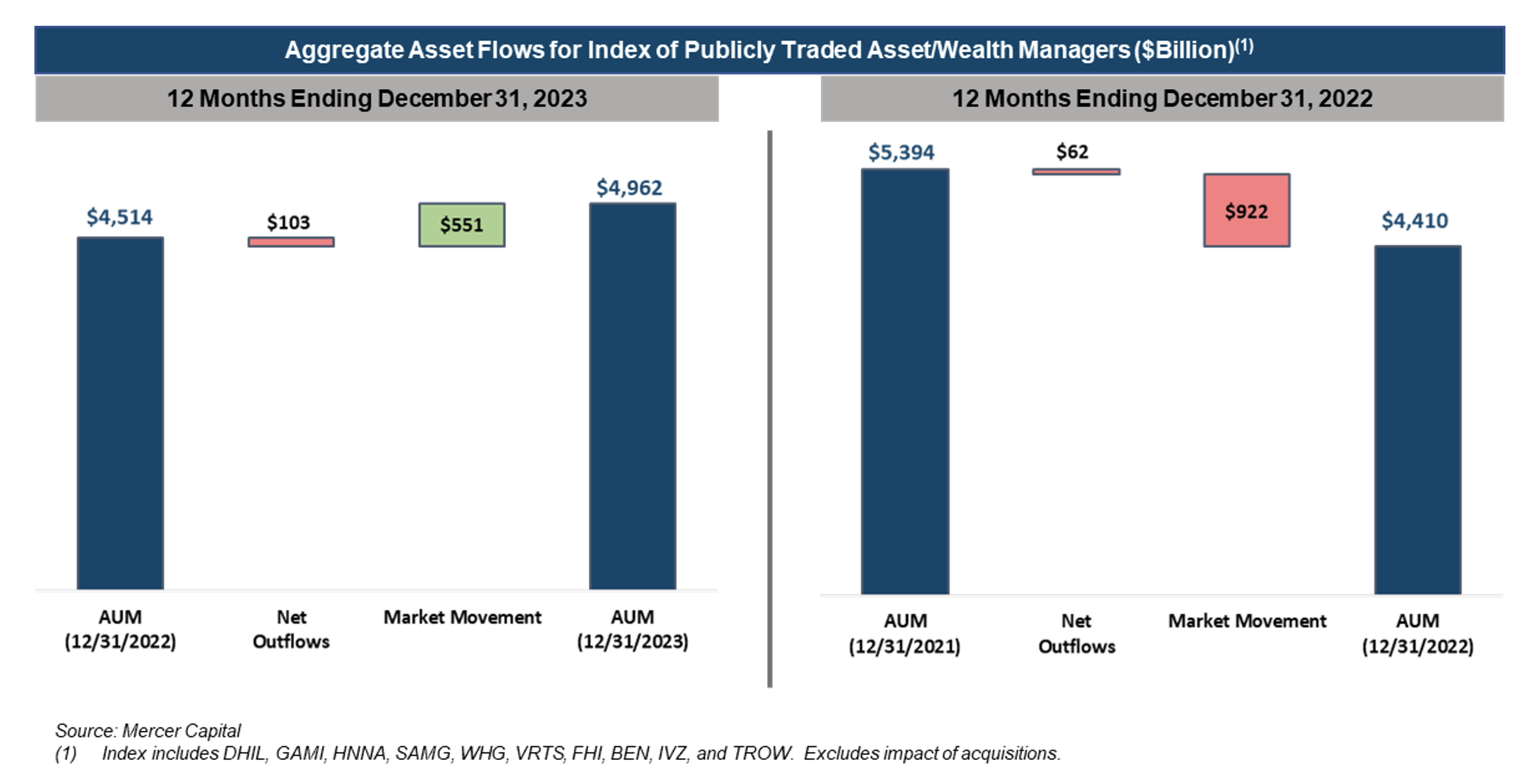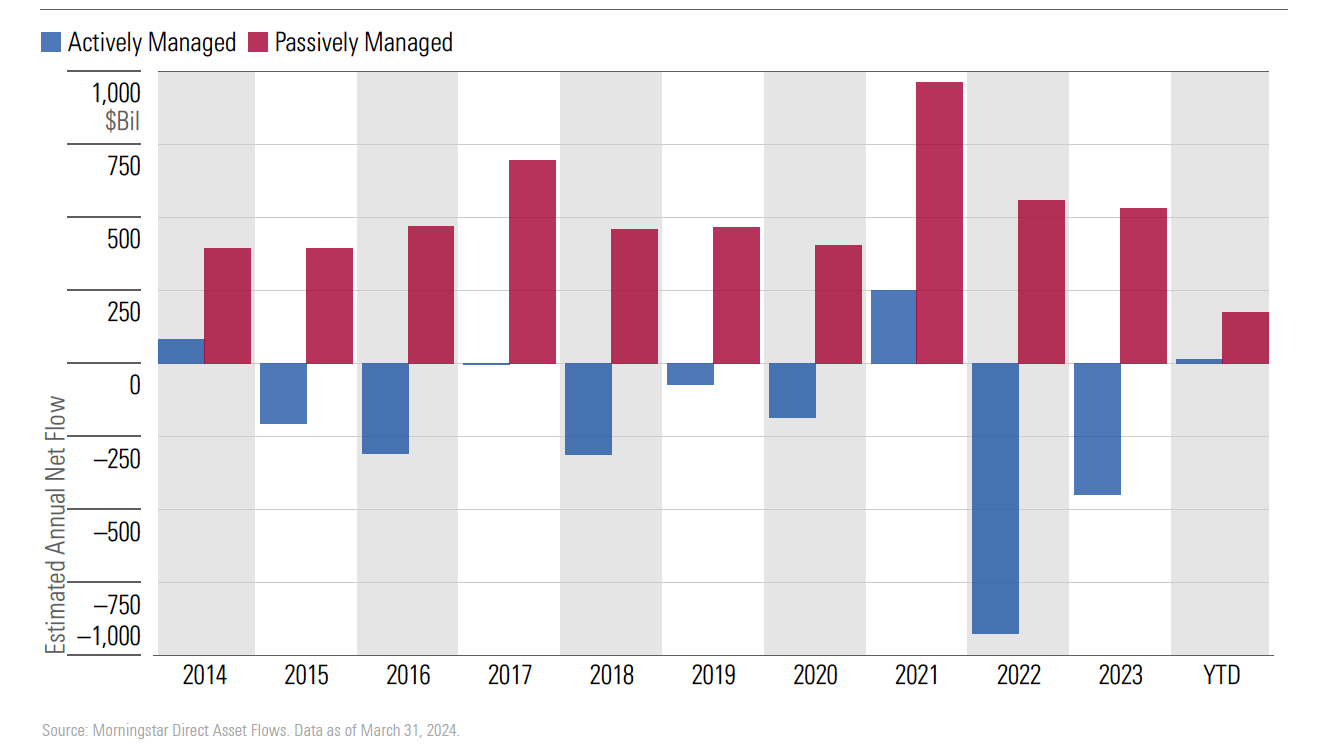Market Resilience: Asset Managers Thrive Amidst Economic Volatility in 2023
Despite persistent inflation, elevated interest rates, and heightened geopolitical tensions, the asset management industry and the stock market as a whole saw a resurgence during 2023. Our index of publicly traded asset management firms generally tracked the movement in the broader market, with stock prices for smaller asset managers (AUM under $250 billion) up 30.3% and large asset managers (AUM over $250 billion) up 22.0% over the year ended March 31, 2024, while the broader market (S&P 500) was up 29.9%.

Fund Flows
While market movement is often the dominant contributor to AUM changes over a particular period, it’s a variable that’s largely outside a manager’s control. On the other hand, organic growth can be influenced by the quality of a firm’s marketing and distribution efforts and can be a real differentiator between asset management firms over longer periods.
Many asset managers have struggled with organic growth in recent years, partly due to rising fee sensitivity and the influence of passively managed investment products. This year proved no different, with our index of publicly traded asset/wealth management companies seeing $103 billion in aggregate net outflows, compared to aggregate net outflows of $62 billion in 2022.
As expected, considering the performance of the stock and bond markets over the past year, market movement was the primary driver of the change in AUM, accounting for $551 billion additional AUM for the index during 2023. During the challenging market conditions of 2022, the index saw an aggregate $922 billion decrease in AUM due to market movement.

Click here to expand the image above
Outflows from Active Funds Accelerate
While asset managers saw net outflows over the past twelve months, there were significant variances between active and passively managed funds. Fund flow data from Morningstar (table below) shows that total outflows across active funds for the year ended March 31, 2024, were approximately $377 billion. The aggregate outflows over the past year were most severe for U.S. equity, allocation, and international equity, with these asset classes shedding a combined $427 billion in assets. All categories of actively managed funds except alternative investments, taxable bonds, alternatives, and nontraditional equities saw net outflows over the past year.
On the other hand, passively managed funds continued to outpace active funds in terms of net new assets over the past twelve months. The Morningstar data shows that total inflows across passively managed funds for the year ended March 31, 2024, were approximately $621 billion, with all asset classes except commodities and miscellaneous assets reporting positive net inflows.

Click here to expand the image above
As you can see from the following chart, there has been a trend over the past ten years of investors moving from active to passive funds, and this trend accelerated with the market downturn in 2022. The relative underperformance of active managers, when compared to their benchmarks over the past ten years, has driven investors to low-fee passive funds. This trend will likely continue to pose a challenge for many types of active asset managers in attracting new assets.

Click here to expand the image above
Outlook
The outlook for asset managers depends on several factors. Investor demand for a particular manager’s asset class, recent relative performance, fee pressure, rising costs, and regulatory overhang can all impact RIA valuations to varying extents. Alternative asset managers tend to be more idiosyncratic but are still influenced by investor sentiment regarding their hard-to-value assets.
With inflation starting the year higher than expected, it remains to be seen if the Fed will be able to implement the rate cuts that many investors expect to come during 2024. With the prospect of interest rates remaining higher for longer, persistent inflation, and geopolitical tensions, there is much uncertainty in the market heading into 2024. Despite these challenges, the industry enters 2024 with higher starting AUM levels, offering a potential boost to revenues and earnings. Navigating these uncertain times requires a proactive approach to capitalize on emerging opportunities and mitigate risks effectively.
About Mercer Capital
We are a valuation firm that is organized according to industry specialization. Our Investment Management Team provides valuation, transaction, litigation, and consulting services to a client base consisting of asset managers, wealth managers, independent trust companies, broker-dealers, PE firms and alternative managers, and related investment consultancies.
 RIA Valuation Insights
RIA Valuation Insights 






